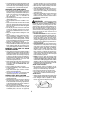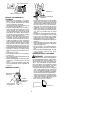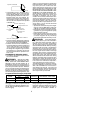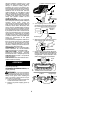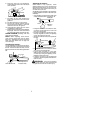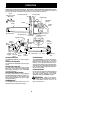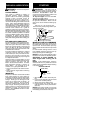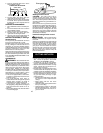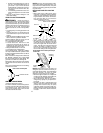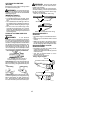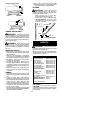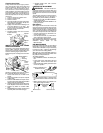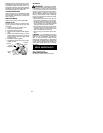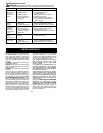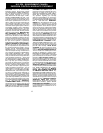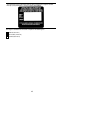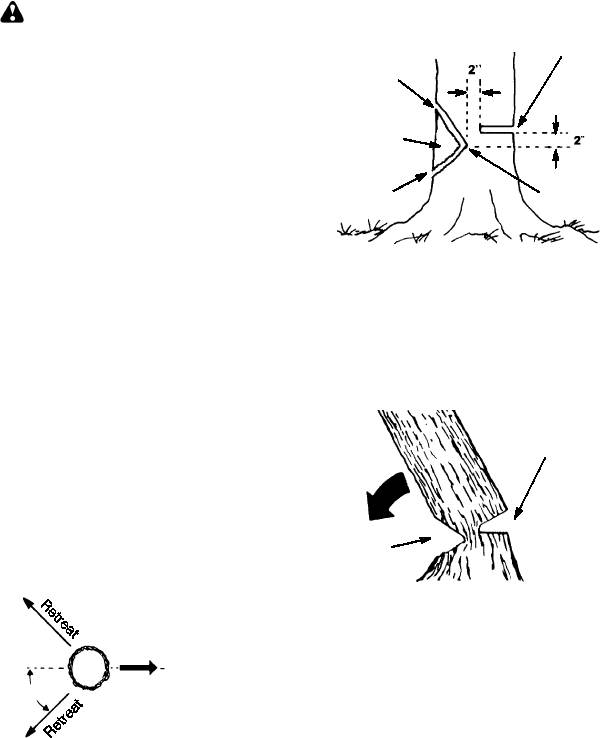
11
S Release the throttle trigger as soon as
the cut is completed, allowing the en-
gine to i dle. If you run the s aw at f ull
throttle without acutting load,unneces-
sary wear can occur to the chain, bar,
and engine.
S Toavoidlosing controlwhencut iscom-
plete,donotputpressureonsaw atend
of cut.
S Stop the engine before setting the saw
down after cutting.
TREE FELLING TECHNIQUES
W ARNING:
Check for broken or
dead branches which can fall while cutting
causing serious injury. Do notcut nearbuild-
ings or electrical wires if you donot knowthe
direction of t reefall, norcut atnight s ince you
will not be ale to see well, nor during bad
weathersuch as rain, s now,or strong w inds,
etc.
S Carefully planyour sawing oper ationin ad-
vance.
S Cleartheworkarea. Youneeda clear area
all aroundthe treeso you can have s ecure
footing.
S Study the natural conditions that can cause
thetreetofallinaparticulardirection.
Natural conditions that can cause a tree to
fall i n a par ticular direction include:
S The wind direction and speed.
S The lean of the tree. The lean of a tree
might not be apparent due to uneven or
sloping terrain. Use aplumb or level to de-
termine the direction of tree lean.
S Weight and branches on one side.
S Surrounding trees and obstacles.
Loo k for decay and rot. If the trunk is rotted , it
can snap and fa ll toward the opera tor . Check
for broken or d ead branches wh ich can fall on
yo u while cuttin g.
Make sure there is enough room for the tree to
f all. Maintain a d istance of
2-1/ 2
tree lengths
from the nearest p erson or oth er objects. En-
gine no ise can d rown o ut a warning ca ll.
Remove dirt, stones, loose bark, nails, staples,
and wire from the tree where cuts are to be
made.
Plan aclear retreat pathto therear anddiag-
onal to the line of fall.
Direction of Fall
45_
Plan a clear retreat path
FELLING LARGE TREES
(6 inches in diameter or larger)
The notch method is used to fell large trees.
A notchis cut on the side ofthetreein thede-
sired direction of fall. After a felling cut is
made on the opposite side of tree, the tree
will tend to fall into the notch.
NOTE:
If the tree has large buttr ess roots,
remove thembeforemaking thenotch. If us-
ing saw to remove buttress roots, keep saw
chain from contacting groundto preventdull-
ing of the chain.
NOTCH CUT AND FELLING THE
TREE
S Make notch cut by cutting the top of the
notch first. Cut through
1/3
of the diameter
ofthetree. Nextcomplete thenotch bycut-
ting the bottom of the notch. See illustra-
tion. Once the notch is cut remove the
notch of wood from the tree.
Notch
First cut
Second cut
Final (felling) cut here. 2 inches
above center of notch.
Hinge
S After removing the cutout of wood, make
the felling cut on the opposite side of the
notch. This is doneby making a cut about
two inches higher than the center of the
notch. This will leave enough uncut w ood
between the felling cut and the notch to
form a hinge. This hinge will help prevent
the tree from falling in the wrongdirection.
Opening
of felling
cut
Closing of
notch
Hinge holds tree on stump and helps
control fall
NOTE:
Before felling cut is complete, use
wedges to open the cut when necessary to
controlthedirectionof fall. Toavoid kickback
and chain damage, use wood or plastic
wedges, but never steel or iron wedges.
S Be alert t o signs that the tree is ready to fall:
cracking soun ds, widenin g of the fe lling cu t ,
or movemen t in t h e up pe r bra nch es.
S As tree starts to fall, stop saw, put it down,
and get away quickly on your planned re-
treat path.
S DO NOT cut down a partially fallen tree
with your saw. Be extremely cautious with
partially fallen trees that may be poorly
supported. When a tree doesn’t fall com-
pletely,setthesawasideandpull downthe
tree with a cable winch, block and tackle,
or tractor.



